Cart vs Kart Which Spelling to Use refers to the common confusion between two similar-sounding words that carry entirely different meanings. “Cart” typically denotes a wheeled container or vehicle used to carry goods, whether in a grocery store, a warehouse, or online shopping. On the other hand, “kart” often points to a lightweight, small racing vehicle designed for speed and entertainment—especially in the context of go-kart tracks and video games like Mario Kart. Despite sharing identical pronunciation, these words belong to different worlds in usage and context. Our latest blog explains Cart vs Kart Which Spelling to Use with simple examples.
What makes this pair so interesting is not just the spelling, but how one tiny letter swap can shift your message entirely. It’s like choosing between shopping and racing—two completely different scenarios. This isn’t just about spelling—it’s about using the right word for the right setting, and avoiding embarrassing mix-ups in writing, speech, or branding.
Understanding the difference between cart vs kart which spelling to use can instantly boost your writing clarity, especially in everyday communication or creative content. Whether you’re crafting a blog post, creating a product label, or developing a video game, knowing this subtle but significant difference ensures your message lands accurately every time.
The Traditional “Cart”: Definition & Uses

The word “cart” has been with us for centuries, evolving from ancient transportation methods to modern commercial applications. A cart, in its traditional sense, refers to a vehicle with wheels designed primarily for transporting goods or people. Many people get confused about Cart vs Kart Which Spelling to Use in everyday writing.
Historical Context of Carts
Carts represent some of humanity’s earliest transportation technology. From simple wooden platforms with wheels pulled by animals to sophisticated modern designs, carts have been instrumental throughout human history.
Ancient civilizations relied heavily on carts for:
- Agricultural transportation
- Trade and commerce
- Military logistics
- Personal transportation
Archaeological evidence shows cart usage dating back to at least 3500 BCE, with early examples found in Mesopotamia and throughout Europe and Asia. These early carts featured solid wooden wheels and were typically pulled by oxen or other draft animals.
Modern Cart Definitions Across Industries
Today, the word “cart” appears in numerous contexts with specific meanings:
| Industry | Cart Definition | Common Examples |
|---|---|---|
| Retail | A wheeled container for gathering purchases | Shopping cart, grocery cart |
| Food Service | Mobile platform for serving or displaying food | Dessert cart, food cart |
| Golf | Small vehicle for transporting players and equipment | Golf cart |
| Agriculture | Farm implement for hauling produce or supplies | Harvest cart, hay cart |
| Transportation | Traditional animal-drawn vehicle | Horse-drawn cart, donkey cart |
| Material Handling | Industrial equipment for moving goods | Hand cart, utility cart |
In modern usage, a cart is generally characterized by its utilitarian nature—designed primarily for practical transportation rather than sport or recreation. If you’re not sure about Cart vs Kart Which Spelling to Use, this guide will help you choose the right word.
Common Types of Carts You Encounter Daily
Most of us interact with various carts regularly without giving much thought to the term. Some everyday examples include:
- Shopping carts in grocery stores and retail outlets
- Service carts in hotels and restaurants
- Luggage carts at airports and hotels
- Utility carts in warehouses and hospitals
- Vending carts for street food and merchandise
- Library book carts
These practical tools share common features: wheels, storage capacity, and a design optimized for transporting items rather than for speed or competition. Teachers often clarify Cart vs Kart Which Spelling to Use when teaching homophones.
Visual Characteristics That Define a True Cart
What distinguishes a cart visually? Several key design elements typically identify something as a “cart” rather than another wheeled conveyance:
- Functionality over form: Carts prioritize practical use rather than aesthetic appeal or speed
- Load-bearing structure: Designed primarily to carry goods or people
- Simple wheel configuration: Usually featuring four wheels for stability
- Push/pull operation: Moved by human power or animal traction rather than motors
- Practical materials: Constructed from durable, utilitarian materials
When you see a wheeled platform designed primarily for transporting goods in everyday settings, “cart” is almost certainly the correct spelling. For better writing accuracy, understanding Cart vs Kart Which Spelling to Use is essential.
“Kart” Defined: When This Spelling Takes the Lead
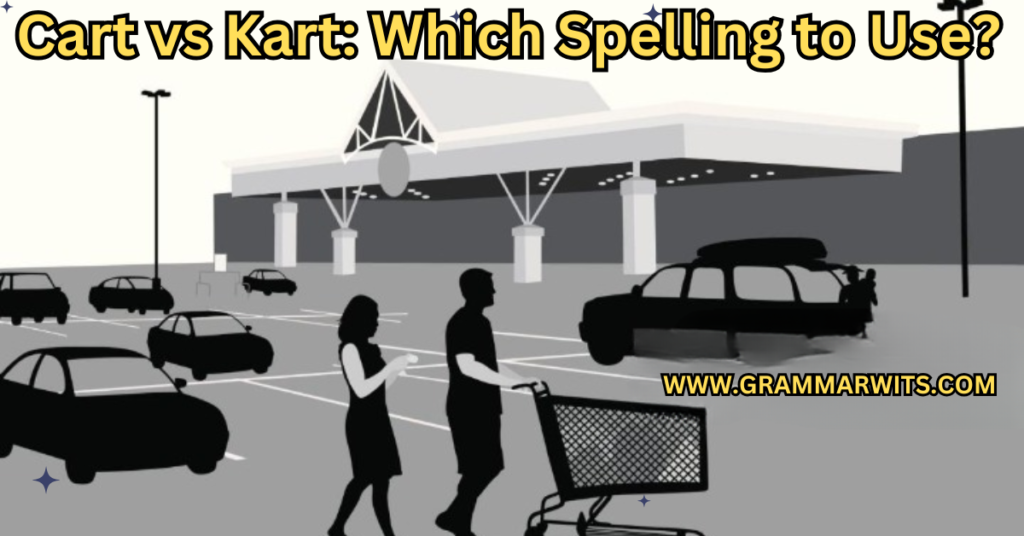
The term “kart” represents a much more recent addition to the English language, with specific applications in racing and recreation. Understanding when to use this spelling can help avoid confusion.
The Specialized Meaning Behind “Kart” Spelling
A “kart” specifically refers to a small, open, four-wheeled vehicle designed for racing or recreation. Unlike the utilitarian cart, a kart is built for performance, speed, and competitive driving.
The key defining characteristics of a kart include:
- Low-to-the-ground design for improved stability and handling
- Open cockpit with no roof or enclosed body
- Small, lightweight frame
- High power-to-weight ratio
- Minimal suspension
- Direct steering mechanism
This specialized spelling emerged specifically to distinguish recreational and competitive racing vehicles from traditional utility carts. This article covers all you need to know about Cart vs Kart Which Spelling to Use in different contexts.
Go-Karts vs Racing Karts: Technical Distinctions
While often used interchangeably in casual conversation, there are meaningful technical differences between recreational go-karts and professional racing karts:
Recreational Go-Karts:
- Designed for amusement parks and rental facilities
- Lower power output for safety
- Simplified handling characteristics
- Reinforced bumpers and safety features
- Speed limiters and remote shut-off capabilities
- Focus on durability over performance
Professional Racing Karts:
- Engineered for competitive motorsport
- Higher power-to-weight ratios
- Sophisticated tuning capabilities
- Specialized tires for various track conditions
- Advanced braking systems
- Customizable setup options
Both types correctly use the “kart” spelling, distinguishing them from utility carts.
Why Manufacturers and Enthusiasts Insist on This Spelling
The “kart” spelling isn’t just a stylistic choice—it serves important functions in the racing and entertainment industries:
- Trademark protection: Manufacturers can more easily trademark specific kart models without confusion with utility carts
- Technical precision: Racing organizations need clear terminology for regulations and classifications
- Market differentiation: Helps consumers distinguish between recreational vehicles and utility equipment
- Cultural identity: Creates a sense of community and specialized knowledge among racing enthusiasts
As kart racing evolved into a serious sport with international competitions, the distinct spelling helped establish it as a separate field with its own terminology and standards.
Regional Variations in Kart Terminology
While “kart” is now the standard international spelling for racing vehicles, some regional variations persist:
- In parts of the United Kingdom, “karting” and “kart racing” are commonly used, though “go-carting” occasionally appears in informal usage
- In Australia, “kart” is strictly used for racing contexts
- In North America, both spellings appear, though professional organizations exclusively use “kart”
- In non-English speaking countries, the English word “kart” is often adopted directly into the local language
This standardization has helped establish go-kart racing as a globally recognized sport with consistent terminology.
Etymology: Tracing the Origins
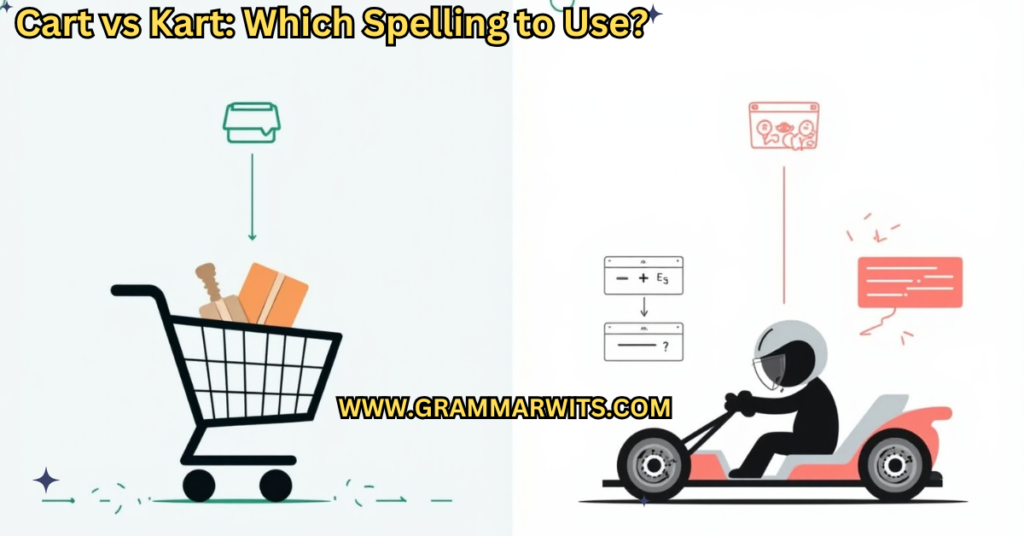
The divergence between “cart” and “kart” reveals fascinating insights into how language evolution shapes our vocabulary over time.
Ancient Roots of “Cart”
The word “cart” traces back to Old Norse “kartr” and Old English “cræt,” making it one of the oldest vehicle terms still in common use. Throughout the centuries, its meaning has remained remarkably consistent—a wheeled vehicle for transportation.
The etymology of “cart” follows a clear linguistic path:
- Proto-Germanic *krataz (wheeled vehicle)
- Old Norse kartr
- Middle English cart
- Modern English cart
Throughout this evolution, the meaning remained focused on utility vehicles for transporting goods, showing remarkable stability across more than a thousand years of language evolution.
When “Kart” Entered the Lexicon
The spelling “kart” emerged much more recently—specifically in the mid-20th century with the invention of go-karts. Art Ingels, often credited as the father of karting, built the first go-kart in 1956 in California.
The distinctive spelling appears to have been adopted deliberately to:
- Distinguish these new recreational vehicles from traditional carts
- Create a memorable, slightly unusual spelling for marketing purposes
- Allow for trademarking and branding without confusion
By 1959, the first kart manufacturing companies had formed, and the specialized spelling was firmly established in racing circles.
How “Go-Cart” Transformed into “Go-Kart”
The term “go-cart” actually predates modern karting, originally referring to:
- Children’s push toys
- Small, human-powered wheeled devices
- Early learning tools for walking infants
When motorized racing versions emerged in the 1950s, manufacturers and enthusiasts gradually shifted from “go-cart” to “go-kart” to distinguish these new vehicles from the children’s toys and push carts that preceded them.
This transition happened gradually over the 1950s and 1960s, with racing organizations and manufacturers leading the change. By the 1970s, “go-kart” (with a “k”) had become the standard spelling in racing contexts.
Linguistic Analysis of the Spelling Divergence
From a linguistics perspective, the cart/kart distinction represents an interesting case of deliberate spelling modification to create lexical distinction. Similar examples in English include:
- Crisp/krisp (for certain snack foods)
- Classic/klassic (for stylized marketing)
- Coffee/koffee (for branded products)
The “k” spelling often conveys a sense of uniqueness, modernity, or specialized usage—exactly what early kart manufacturers wanted to establish. This intentional spelling variation has now become standardized and accepted in formal writing about motorsport.
Context Is Key: Industry-Specific Usage
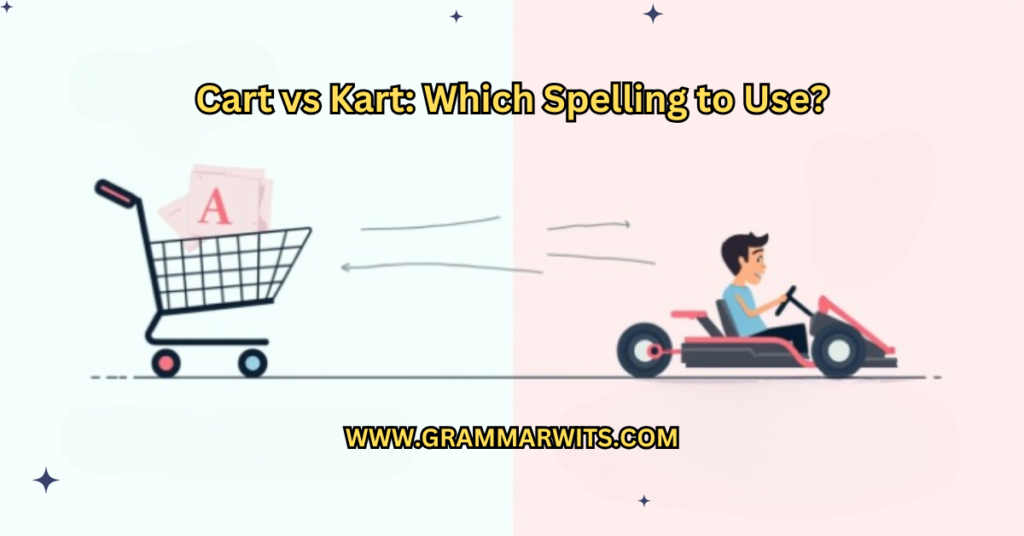
Perhaps the most practical approach to choosing between “cart” and “kart” is to consider the specific context and industry where the term will be used.
Retail/Shopping Context: Always “Cart”
In retail environments, “cart” is invariably the correct spelling. This applies to:
- Physical shopping carts in stores
- Virtual shopping carts in online shopping platforms
- Specialty retail carts like flatbeds or bulk item carts
The retail industry has universally maintained the traditional spelling, likely because these tools directly descend from traditional transportation carts without requiring the specialized distinction needed in racing contexts.
“Our data shows that large shopping carts increase average purchase amounts by 19% compared to baskets or small carts.” — National Retail Federation Study, 2023
For e-commerce platforms, the shopping cart metaphor preserves the traditional spelling even in the digital realm, maintaining semantic similarity with physical retail experiences.
Motorsports Context: The Dominance of “Kart”
In racing environments, “kart” is not just preferred—it’s considered the only correct spelling. Organizations including:
- The International Kart Federation
- World Karting Association
- Commission Internationale de Karting (CIK-FIA)
All exclusively use the “kart” spelling in their official documentation, regulations, and communications. This standardization helps maintain clarity in a technical field where precise terminology matters.
A professional driver would never refer to their racing vehicle as a “cart”—doing so would immediately identify someone as an outsider to the sport.
Gaming World Distinctions
Video games have their own conventions regarding these terms:
- Mario Kart: Nintendo’s famous racing franchise uses “kart” to emphasize the racing aspect
- Shopping cart mechanics in games like Fortnite use “cart” to reference utility vehicles
- Simulation racing games follow professional conventions with “kart”
The gaming industry largely follows real-world conventions, using each spelling according to whether the virtual vehicle is designed for racing or utility.
Media Representation and Popular Culture Influences
Media coverage and popular culture have helped solidify these distinctions:
- Racing coverage consistently uses “kart” for motorsport contexts
- Retail and shopping coverage uses “cart” for utility vehicles
- Children’s entertainment often uses “kart” when emphasizing fun and speed
This consistent usage in media has helped reinforce the appropriate contexts for each spelling in everyday language.
Common Mistakes & How to Avoid Them
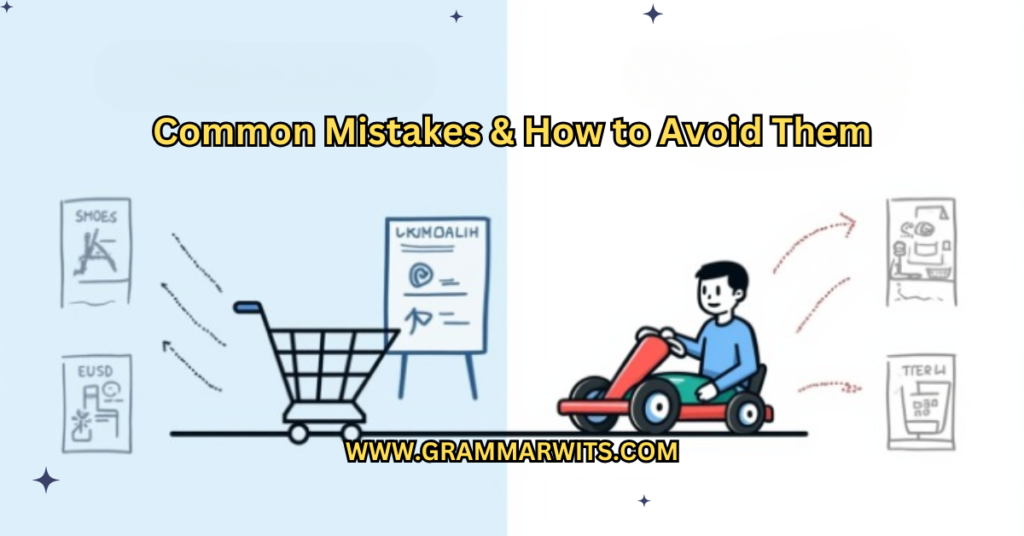
Despite the relatively clear distinction between these terms, confusion persists. Here’s how to avoid common mistakes:
Most Frequently Confused Contexts
The contexts where writers most commonly misuse these terms include:
- Describing amusement park attractions: These are always “karts” (or “go-karts”), not “carts”
- Mentioning video game racing: Games like Mario Kart use “kart,” not “cart”
- Discussing professional karting: The sport is “karting,” never “carting”
- Writing about historical transportation: Traditional vehicles are “carts,” not “karts”
When in doubt, consider whether the vehicle is designed primarily for racing/recreation (kart) or utility/transportation (cart).
Tips for Remembering the Correct Spelling by Context
A few simple memory aids can help keep these spellings straight:
- K for speed: “Kart” has a K, which looks faster and more dynamic than C
- C for carrying: “Cart” has a C, which relates to its carrying function
- Racing = K: If it’s about racing, use K
- Shopping = C: If it’s about shopping or utility, use C
Creating these mental associations can help writers make the correct choice instinctively.
Professional Writing Standards for Each Term
Style guides and professional publications maintain consistent standards:
- AP Style: Distinguishes between “go-kart” for racing and “cart” for utility
- Chicago Manual of Style: Follows standard usage with “kart” for racing contexts
- Industry publications: Strictly observe the distinction based on vehicle purpose
Professional editors will immediately flag incorrect usage in formal writing, making it important to master this distinction for published work.
Spell Checker Limitations with These Terms
Be aware that many spell-checking programs may flag “kart” as a misspelling or automatically “correct” it to “cart.” This automatic correction often leads to errors in documents about racing or recreation.
Always double-check any automated spelling corrections when writing about these topics, and consider adding “kart” to your spell checker’s dictionary to prevent unwanted “corrections.”
Real-World Examples & Practical Applications
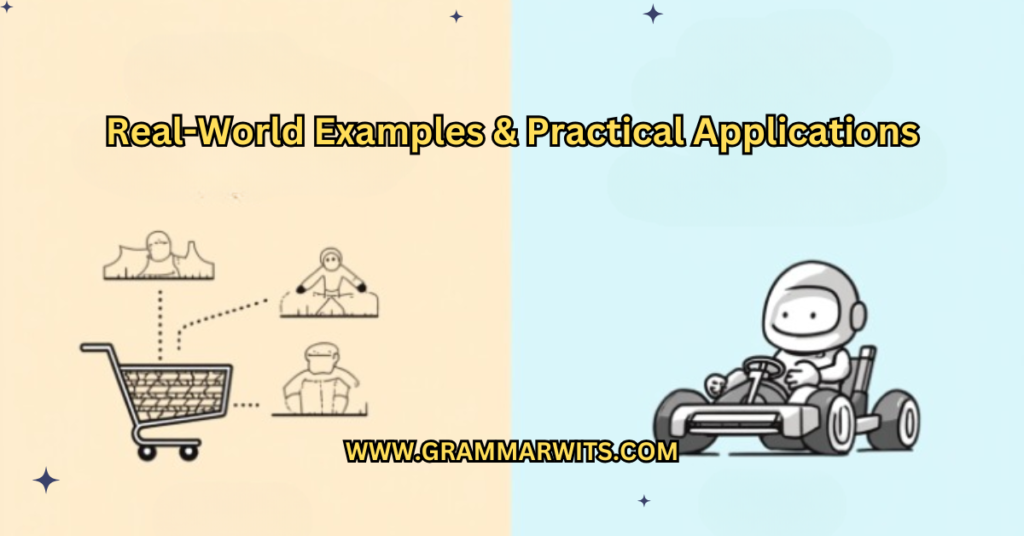
Seeing these terms in context can help clarify their proper usage across different scenarios.
Product Descriptions: When to Use Each Spelling
For product marketing and descriptions, using the correct term is essential for both accuracy and search engine optimization:
Cart Examples (Correct):
- “Our heavy-duty utility cart can handle loads up to 300 pounds.”
- “This collapsible shopping cart folds flat for easy storage.”
- “The hotel luggage cart features silent rubber wheels and elegant brass accents.”
Kart Examples (Correct):
- “This racing kart reaches speeds up to 60 mph with its 125cc engine.”
- “Rental go-karts available for ages 12 and up—experience the thrill of the track!”
- “Professional kart chassis with adjustable geometry for competitive racing.”
Using the wrong spelling in product descriptions can confuse customers and harm your credibility with enthusiasts who know the difference.
Signage and Marketing Considerations
For physical signage and marketing materials, the correct spelling helps target the right audience:
- Amusement parks advertise “Go-Kart Rides,” not “Go-Cart Rides”
- Retail stores direct customers to “Cart Return Areas,” not “Kart Return Areas”
- Racing facilities promote “Kart Racing Experiences,” not “Cart Racing Experiences”
Digital Content Optimization for Search Engines
From an SEO perspective, using the correct spelling is crucial since people searching for specific products or services typically use the standard spelling:
- Those looking for racing experiences search for “kart racing” or “go-kart tracks”
- Shoppers search for “shopping cart plugins” for e-commerce
- Businesses search for “utility carts” for workplace applications
Using incorrect spelling can significantly reduce your visibility to potential customers searching online.
Legal and Trademark Implications of Incorrect Usage
Beyond clarity, there can be legal implications to using the wrong term, particularly when:
- Drafting contracts for manufacturing or distribution
- Filing patents or trademarks related to these products
- Creating regulatory documentation or safety standards
The distinct spellings help maintain clear legal boundaries between different classes of products with different safety requirements and standards.
Visual Differences: Cart vs Kart Design Elements
The spelling distinction reflects genuine design differences between these vehicle types.
Structural Characteristics That Differentiate the Two
Cart Design Elements:
- Higher center of gravity
- Four wheels arranged in rectangle configuration
- Storage capacity prioritized
- Push/pull handles or animal harness attachments
- Vertical sides for containing goods
- Durability-focused construction
Kart Design Elements:
- Extremely low center of gravity
- Four wheels with specialized racing geometry
- Single-seat design (typically)
- Steering wheel and pedal controls
- Exposed mechanical components
- Performance-focused construction
These design differences reflect the fundamental purpose of each vehicle: utility versus performance.
Design Evolution Timeline of Both Vehicles
The evolution of carts and karts shows their divergent development paths:
Cart Evolution:
- Ancient wooden carts (3500 BCE): Animal-drawn with solid wooden wheels
- Medieval carts (500-1500 CE): Improved wheels, specialized designs for trade
- Industrial Revolution carts (1800s): Metal components, standardized designs
- Modern utility carts (1900s-present): Specialized designs for specific industries
- Digital “shopping carts” (1990s-present): Virtual extension of the cart concept
Kart Evolution:
- First go-kart by Art Ingels (1956): Basic motorized chassis with lawnmower engine
- Early commercial karts (late 1950s): Simple tubular frames with minimal features
- Competition karts (1960s): Specialized racing designs emerge
- Modern racing karts (1980s-present): Sophisticated engineering with class regulations
- Electric karts (2000s-present): Battery-powered alternatives gaining popularity
This parallel evolution shows how the shared conceptual origin diverged into two distinct vehicle categories, justifying the spelling distinction.
Component Analysis: What Makes a Kart Different from a Cart?
A detailed component comparison highlights the technical differences:
| Component | Cart Design | Kart Design |
|---|---|---|
| Frame | Box-like, storage-focused | Tubular, low-profile chassis |
| Wheels | Equal size, often with casters | Rear wheels larger than front |
| Power Source | Human, animal, or small utility motor | Performance engine or electric motor |
| Steering | Simple directional control | Precision racing steering |
| Brakes | Basic stopping mechanism (if any) | High-performance racing brakes |
| Suspension | Minimal or none | Chassis flexibility as suspension |
| Seating | Multiple passengers or none | Single driver position |
These fundamental design differences reinforce why distinct terminology evolved to describe these very different vehicles.
Expert Opinions: What Language Authorities Say
Linguistic experts and dictionary publishers have formally recognized the distinction between these terms.
Style Guide Recommendations
Major style guides acknowledge the distinction:
- AP Stylebook: Recommends “kart” for racing contexts and “cart” for utility vehicles
- Chicago Manual of Style: Supports the industry-standard usage of both terms
- Oxford Style Manual: Recognizes both spellings with their distinct meanings
Professional editors follow these guidelines to maintain consistency in published works.
Dictionary Entries and Their Nuances
Modern dictionaries clearly distinguish between these terms:
- Merriam-Webster Dictionary: Lists “kart” as “a small low-slung four-wheeled vehicle in which the driver sits a few inches above the ground; used for racing”
- Oxford English Dictionary: Defines “kart” specifically in relation to motorsport and distinguishes it from traditional carts
- Cambridge Dictionary: Specifies “kart” as relating exclusively to racing contexts
These authoritative sources confirm that the different spellings represent genuinely distinct concepts rather than mere spelling variations.
Language Evolution Trends Regarding These Terms
Linguistic data shows interesting trends in usage:
- “Go-kart” (with K) has steadily increased in usage since the 1950s
- “Go-cart” (with C) shows declining usage over the same period
- “Karting” as a sport term has seen consistent growth since the 1960s
- Digital “shopping cart” usage exploded in the 1990s with e-commerce
These trends suggest that the terminological distinction has become increasingly standardized over time, with “kart” firmly established in racing contexts.
Conclusion
Choosing the correct word matters. “Cart” and “kart” may sound the same, but they mean different things. “Cart vs Kart Which Spelling to Use” is about knowing the right word for the right situation. Use “cart” when talking about shopping, delivery, or moving goods. Use “kart” when referring to small racing vehicles or video games like Mario Kart. One letter can change the whole meaning of your sentence. Confused about Cart vs Kart Which Spelling to Use? We break it down so you never mix them up again.
Knowing the difference helps you write clearly and avoid confusion. “Cart vs Kart Which Spelling to Use” is a simple guide for smarter communication. It’s useful for students, writers, or anyone who wants to get the words right. Keep this tip in mind and your writing will sound more correct and professional. It’s a small detail, but it makes a big difference.
Practical Summary of When to Use Each Spelling
To apply this knowledge practically:
- Use “cart” for:
- Shopping and retail contexts
- Utility and transportation vehicles
- Agricultural implements
- Historical references to wheeled transport
- Digital e-commerce “baskets”
- Use “kart” for:
- Racing vehicles (whether professional or recreational)
- Amusement park ride vehicles
- References to motorsport activities
- Video game racing (like Mario Kart)
- Technical discussions of racing equipment
Future Trends in Terminology Usage
As language continues to evolve, we can observe certain trends:
- Increasing standardization of “kart” in all racing contexts
- Growing international adoption of “kart” as the standard term for racing vehicles
- Continued use of “cart” for both physical and digital shopping applications
- More consistent distinction between terms in professional writing
These trends suggest the distinction will likely become even more firmly established rather than converging back to a single spelling.
Final Checklist for Determining the Right Choice
When deciding which spelling to use, ask yourself:
- Is the vehicle designed primarily for racing or recreation? → Kart
- Is the vehicle designed primarily for carrying goods or people? → Cart
- Does it have a low-slung racing design? → Kart
- Is it used in shopping or utility contexts? → Cart
- Are you referring to a motorsport? → Kart
- Are you discussing e-commerce? → Cart
By applying these simple questions, you can ensure consistent and accurate usage of these terms in your writing.
FAQ Section
Q: Are “go-cart” and “go-kart” interchangeable?
A: No. “Go-kart” is the standard spelling for recreational and racing vehicles. “Go-cart” is considered obsolete or incorrect in modern usage when referring to motorized racing vehicles.
Q: Do British and American English differ on cart/kart spelling?
A: No. Both British English and American English follow the same convention: “kart” for racing vehicles and “cart” for utility vehicles.
Q: What about compound terms like “golf cart” vs “golf kart”?
A: “Golf cart” is the correct term since these vehicles are utility-focused rather than racing-oriented, despite having motors.
Q: Is “karting” a recognized sport?
A: Yes. Karting is officially recognized by the Fédération Internationale de l’Automobile (FIA) and serves as the entry-level motorsport for many Formula 1 drivers.
Q: How should I spell it in professional or academic writing?
A: Follow the context-based rule: “kart” for racing contexts and “cart” for utility contexts. This distinction is recognized by major style guides and dictionaries.
Q: What about in digital contexts like “shopping cart” for e-commerce?
A: Always use “cart” for e-commerce applications, following the utility vehicle convention rather than the racing one.
By understanding these distinctions, you can use these similar-sounding but contextually different terms with confidence and precision in all your writing.

Alizy Smith is a passionate language enthusiast and the admin of Grammar Wits. With a love for wordplay, grammar quirks, and witty expressions, she’s dedicated to making language learning fun and accessible. From grammar tips to pun-filled laughs, Alizy ensures every piece of content entertains while educating — turning tricky rules into easy, enjoyable reads.
